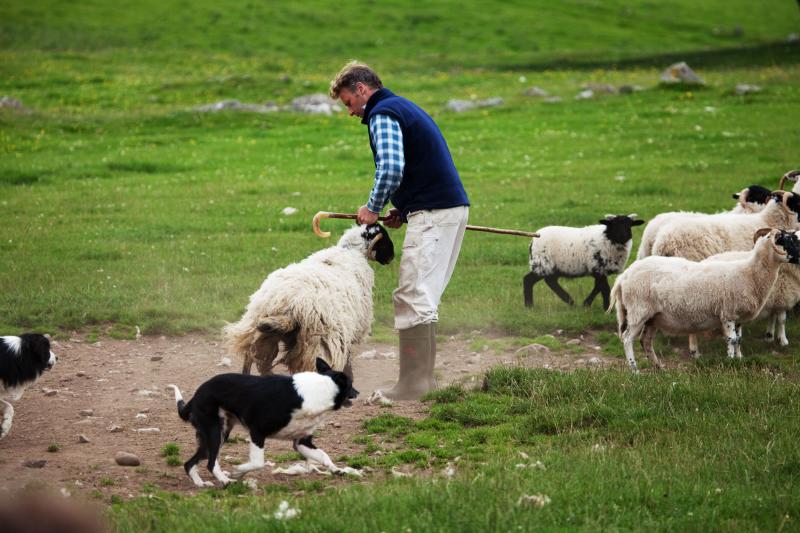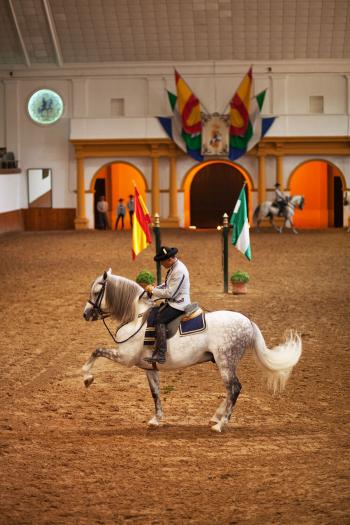Going to the dogs (and other animals) in Europe
Appears in the Online Edition, August 2018.
Despite a lifetime of European travel, there is a world of firsts still out there for me. And recently, I had my first falconry experience.
It was at the Ireland School of Falconry (just outside of Cong, north of Galway), where a great guide took our tour group on a "hawk walk." For about an hour, we wandered through the enchanting grounds of Ashford Castle, with our guide sporting a Harris hawk on his forearm. After learning about falconry, each person in our group got an opportunity to toss and catch a bird on his or her arm. With each toss, the glove was rotated to the next person and the guide tucked a little chicken meat in the padded palm -- and the hawk knew just where to return. The experience was both intimate and intense.
Throughout Europe, you'll find vivid and memorable animal demonstrations and experiences. They run the gamut, from famous festivals (Pamplona's Running of the Bulls or Siena's Palio horse race) to routine rituals (sheep shearing or dog feeding). Whether big and raucous or small and intimate, I always find these experiences fascinating.
At Chateau de Cheverny in France's Loire Valley, barking dogs remind visitors that the viscount, who still lives there, loves to hunt. The kennel is the scene of a unique feeding frenzy each day at 11:30 a.m. -- a fun spectacle that shows off their strict training.
As feeding time nears, the 70 hounds -- half English foxhound and half French Poitevin -- get worked up knowing that red meat is on the way. The trainer corrals the dogs and spreads out the feast. They're fed just once a day, so the excitement is palpable. The trainer then opens the gate and maintains discipline as the dogs, who can only eat when the trainer gives the go ahead, gather enthusiastically around the food. It's an exercise in control. Finally he gives the signal ... and it's chow time.
In Vienna, a cultural highlight is seeing the Lipizzaner stallions perform at the magnificent Spanish Riding School. These regal white horses are a creation of Habsburg Archduke Charles, who imported Andalusian horses from Habsburg-ruled Spain and then bred them with a local line. They're known for their noble gait and Baroque profile.
One Sunday morning, I decided to drop in on a performance. I ducked through a royal passageway and paid about $30 for a standing-room spot to see the much loved stallions prance to Viennese classical music in the emperor's chandeliered Baroque riding hall. (While watching, it occurred to me that they prance in 4:4 meter rather than 3:4 -- even though this is the city of the waltz.) I enjoyed the show as much -- and with a view just as good -- as those who booked far more expensive seats long in advance.
Equally impressive is the horse show at the Royal Andalusian School of Equestrian Art in Jerez, Spain. Here, horses -- both purebred Spanish horses and larger mixed breeds -- perform an equestrian ballet with choreography, purely Spanish music, and costumes from the 19th century. The stern riders command their talented, obedient steeds to prance, jump, hop on their hind legs, and do-si-do in time to the music.
While I appreciate the elegance and grandeur of a horse show, I also love the rustic simplicity and intimacy of a sheepdog demonstration. And recently, while traveling through the British Isles, I saw two good ones.
In Ireland, I visited the Kissane Sheep Farm, a 2,500-acre farm perched on a scenic slope above the Black Valley near Killarney, where John Kissane's family has been raising sheep for five generations. During the visit, our group got to know the family, learn of their livelihood and watch highly strung sheepdogs race around according to John's call. As one of the brothers sheared a sheep effortlessly, he told us the Irish wool industry is so bad these days that the farm survives only with the help of money generated by showing off the tradition to visiting tourists.
At Leault Working Sheepdogs in the Scottish Highlands, a dozen eager border collies of all ages scampered to greet us as our bus pulled up. Then came the shepherd, whom the dogs clearly loved and followed like a messiah. He proceeded to sit us down in a natural little amphitheater in the turf to explain his work and demonstrate how he commands his border collies. With shouts and whistles, each dog followed individual commands and showed an impressive mastery over the sheep. On this farm, it was very clear: Sheepdogs are smart -- and sheep are idiots.
The best animal shows are not only interesting and educational, but also vividly real and culturally broadening -- giving insights into generations-old traditions and a different way of life.
(Rick Steves (www.ricksteves.com) writes European travel guidebooks and hosts travel shows on public television and public radio. Email him at rick@ricksteves.com and follow his blog on Facebook.)


